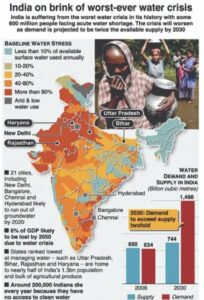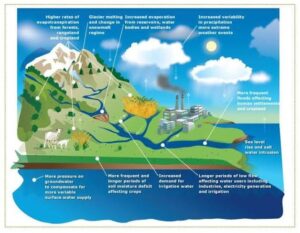Global climate change is occurring in an unprecedented way and its net damage costs are likely to be significant and to increase over time. Water, the precious resource, has been the victim of climate change. This in the long run would have devastating effects on the ecosystem as a whole.
Static dimensions
- What is water stress?
- What is water scarcity?
Current dimensions
- Climate change impact on freshwater sources
- Climate change and Indian Monsoon
- Climate change and water: who are the first victims?
Content:
What is water stress?
The water stress refers to a twofold situation:
- when the demand for water exceeds the current available resource;
- when the poor quality of water restricts its use.
It frequently occurs in areas with low rainfall and high population density or in areas where agricultural or industrial activities are intense. Even where sufficient long-term freshwater resources exist, seasonal or annual variations in the availability of freshwater may at times cause stress.
Water stress causes deterioration of fresh water resources in terms of quantity (aquifer overexploitation, dry rivers, etc.) and quality (eutrophication, organic matter pollution, saline intrusion, etc.). Such deterioration can result in health problems and have a negative influence on ecosystems. The industries are also concerned, for the availability of water proves to be crucial within the industrial process, especially for water-intensive industries.
Water scarcity:
- Water scarcity is the scarcity in availability due to physical shortage, or scarcity in access due to the failure of institutions to ensure a regular supply or due to a lack of adequate infrastructure.
- Water scarcity can be a result of two mechanisms:
-> physical (absolute) water scarcity which is a result of inadequate natural water resources to supply a region’s demand
-> economic water scarcity, which is a result of poor management of the sufficient available water resources.
- According to the United Nations Development Programme (UNDP), the economic water scarcity is found more often to be the cause of regions experiencing water scarcity, as most countries have enough water to meet household, industrial, agricultural, and environmental needs, but lack the means to provide it in an accessible manner.

Causes:
- Climate change – Due to release of more carbon dioxide and other greenhouse gases into the atmosphere, patterns of weather and water will change around the world. Droughts, floods will become more common in some places. Glaciers and snow packs will disappear in some areas, affecting the freshwater supplies to those downstream communities.
- Pollution – Water pollution comes from many sources including pesticides and fertilizers that wash away from farms, untreated human wastewater, and industrial waste. Many pollutants can leach into underground aquifers. Some effects are immediate, as when harmful bacteria make it unfit to drink or usage.
- Agriculture – Agriculture uses 70% of the world’s accessible freshwater, but some 60% of this is wasted due to leaky irrigation systems, inefficient application methods. This wasteful use of water is drying out rivers, lakes and underground aquifers. Agriculture also causes considerable freshwater pollution through fertilizers and pesticides usage.
- Population – The rapid population growth with its accompanying economic development and industrialization has transformed water ecosystems around the world.
Solutions:
Addressing water scarcity requires a multidisciplinary approach. Water resources must be managed with the goal of equitably maximizing economic and social welfare without compromising ecosystem functioning.
- Public education is the key for water conservation efforts.
- All public and environmental policies must utilize sound science for the implementation of sustainable resource management initiatives.
- The preservation and restoration of ecosystems that naturally collect, filter, store, and release water, such as wetlands and forests.
- Water tax on heavy users could deter wasteful water consumption in industry and agriculture while leaving household water prices unaffected.
- Rebates for the replacement of water-wasteful appliances, such as toilets and shower heads are a common and cost-effective alternative.
- Policies that incentivize organic farming and other sustainable farming practices serve to protect water sources from agricultural pollutants.
- Industrial sources of water pollution should be regulated as point sources of pollution.
- Educating farmers about potential water loss from water-intensive practices, funding irrigation improvements and promoting micro-irrigation practices can help reduce wasteful water use in agriculture.
- Desalination has been proposed to curb water scarcity problems in areas with access to brackish groundwater or seawater.
- Recycling and reusing of wastewater can improve the quality of streams and lakes by reducing the polluted effluent discharges that they receive.
- Rainwater harvesting for non potable functions, such as gardening and washing clothes, can significantly reduce both the demand on public freshwater supplies and the strain on stormwater infrastructure.
Climate change impact on freshwater sources:

On Groundwater:
- Increased variability in precipitation and more extreme weather events caused by climate change can lead to longer periods of droughts and floods, which directly affects availability and dependency on groundwater.
- In long periods of droughts there is a higher risk of depletion of aquifers.
- People in water-scarce areas who depend on groundwater will be severely affected.
- Sea level rise may lead to salt water intrusion into coastal aquifers affecting groundwater quality and contaminating drinking water sources.
- Particularly vulnerable are already low-lying coastal zones and small island developing states.
Lakes:
- Unabated global warming will increase surface water temperatures, thus influencing thermal stratification in lakes. A higher surface and air temperature will also increase evaporation of water causing a fall in lake levels unless offset by rainfall increase.
- Alter the capacity of lakes to provide ecosystem goods and services, such as inland fisheries and adequate supplies of safe drinking water.
- Water quality deteriorates through the likely increased abundance of noxious cyanobacteria.
- Changes in water temperature will affect the metabolic rates of aquatic organisms and some species may become extinct.
- Warmer temperatures might allow some newly invading species to survive and complete their life cycles, at the expense of any original species present in that lake ecosystem.
- Will have adverse effects on the physical structure and connectivity of lake ecosystems, their food webs and biodiversity and their biogeochemical characteristics.
Rivers:
- Changes in the timing and location of precipitation combined with rising levels of water pollution will strain ecosystems and threaten the survival of many fish and wildlife species.
- These shifts will have dramatic impacts on communities, threatening public health, weakening economies and decreasing the quality of life in many places.
- Severe droughts in California have dry out riverbeds.
- Precipitation patterns are shifting, benefiting some regions with additional water while reducing snow and rainfall in other areas.
- Rising temperatures will cause more precipitation to fall as rain rather than snow and will melt mountain snowpack earlier in the season, reducing the natural reservoir that feeds rivers through drier summer months.
Climate change and Indian Monsoon:
- As Indian monsoon is rainfed, even relatively small variations in the Indian monsoon can influence things like agricultural production and the stocks and commodities market.
- Variability of rainfall on shorter time scales will have the biggest impacts – intense heavy rainfall leads to flooding and breaks in the monsoon of a week or more lead to water shortage and agricultural drought.
- The interannual variability of the monsoon also depends on events like El Nino.
- It is not just the warming of the planet which is responsible for Monsoon rains but also other factors including aerosols emissions, domestic fires, crop burning as well as land usage changes.
- Excessive use of water for irrigation has caused a negative impact on the moisture of the soil thereby diminishing its capability to reflect or absorb heat.
- According to scientists, since the year 1950, average summer rains in India have declined by around 7 percent.
- High concentrations of aerosols are formed in the northern Indian Ocean and sometimes along Indo-Gangetic plains which absorb solar radiation due to which less of it reaches the surface of the Earth.
- This leads to cooling of land, reducing the contrast of temperature between sea and land, thereby weakening the atmospheric circulation that sustains the Indian Monsoon.
- Changes in circulation in the Indian subcontinent affect air-sea interaction which is the binding factor between Asia and the Indian Ocean.
- Due to the Asian monsoon being linked to other parts of the planet’s climate, aerosols over South Asia may even have global consequences.
Climate change and water: who are the first victims?
- Climate change is contributing to more intense and frequent extreme weather events like wildfires, floods, storms, extreme precipitation, drought, and heatwaves.
- These events contribute to increased stress on water supplies, particularly in drought conditions.
- Wildfires have become annual events that result in the loss of critical infrastructure, people’s homes and community spaces with devastating social, economic and environmental impacts for communities.
- The 2019-2020 bushfires in Australia, fuelled by drought and high temperatures, portrayed well the impacts of climate change on humans and animals.
- Women’s caregiving roles in the household and community are affected by climate change effects on their livelihoods and resources.
- Indoor pollution affects the health of women and children. At least 4 lakh premature deaths in India in a year is because of this indoor pollution.
- Forced migration and environmental displacement due to climate change is taking place in many parts of the world, particularly in Africa and Asia.
- Migration leads to depletion of resources in the host cities.
- According to magazine Springer Nature, 2019, the number of environmental migrants by 2050 is estimated from 25 million to 1 billion.
- Small Pacific islands and countries lying in low areas like Maldives, Bangladesh are very much vulnerable to climate change.
UNFCCC COP-22 held in Morocco saw “water”, as the ‘first victim’ of climate change. Water is the first sector through which the global population suffers the most from the impact of climate change. As water is fundamental for food security, human health, energy production, industrial productivity, biodiversity, in addition to basic human needs and its availability, ensuring water security means ensuring security in all these domains.
Water is critical for successful climate change mitigation, as many efforts to reduce greenhouse gas emissions depend on reliable access to water resources. Hence systematically addressing these challenges is the key to adapting to climate change and reducing the negative impacts of water-related disasters.
Mould your thought:
- Define water stress. How is water becoming the first victim of climate change?
Approach to the answer:
- Explain water stress.
- Explain the effects of climate change on water resources
- Explain how water has been victimised due to climate change
- Conclude by saying what needs to be done to overcome the crisis
















